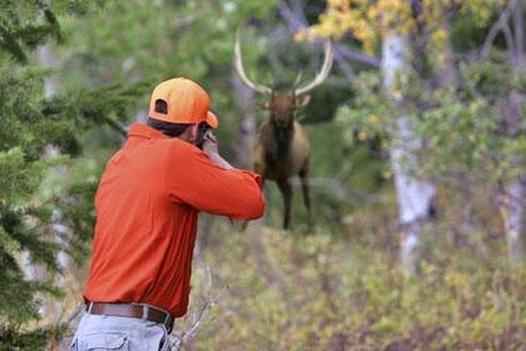|
-- Jennie Miller PhD Candidate  Hunting_Cripple Creek Colorado In suburban neighborhoods across the globe, it is no longer surprising to see deer grazing outside downtown offices in the mid-day sun, brazenly snacking along sidewalks or grazing on gardens as pedestrians pass within petting distance. These animals, once cherished for their shy and flighty nature, now boldly roam among humans and their property, spreading disease and environmental devastation in their wake. Managers have had little success in their attempts to control overabundant ungulates with common methods such as culling and contraceptives, which are also costly and controversial. However, a recent review published in the Journal of Applied Ecology presents a new wildlife management tool that may offer a less bloody and more effective alternative: fear. Over the past decade, ecologists have found mounting evidence of an idea that horror films have exploited over the last century – that the threat of death is scarier than death itself. Just as countless starlets have cowered from mere threats of torture from dark-hooded movie murders, prey animals make great sacrifices to avoid the simple threat of attack from wild carnivores. Just the presence of predators – be they tarantulas, terns or tigers – can elevate stress levels in their prey that hamper feeding, reproduction and ultimately survival. In essence, predators terrify their prey long before they pounce. The non-lethal ‘fear effects’ from carnivores can constrain prey populations as strongly as – if not stronger than – actual kills made by carnivores. Yet most management programs aimed at reducing overabundant deer populations have ignored fear effects, instead using methods such as hunting and birth control that rely on mortality alone to control ungulates. In their March 2013 article, Dr. Joris Cromsig and colleagues highlight the importance of incorporating fear effects into ungulate management. Humans should, basically, scare ungulates to death. Cromsig et al. suggest adapting current practices of hunting to generate greater fear in ungulates. By extending the hunting season and area, hunters could evoke greater and more constant levels of fear in ungulates, creating stress that reduces herd sizes and shifts grazing patterns. But can humans adequately fill the role of large carnivores and limit ungulate populations through fear alone? As a doctoral student who spends hours contemplating how fear affects prey, I found Cromsig et al.’s suggestion intriguing yet in need of additional discussion. In applying ideas about the ‘ecology of fear’ to practical management, Cromsig and colleagues contribute to an emerging conversation on predation risk as a management tool (for examples see Berger 2007 and Treves et al. 2011). Non-lethal fear effects do appear to have great – and largely unexplored – utility for wildlife management issues such as ungulate overgrazing, livestock depredation and carnivore conservation. And by infusing fear effects into current practices of hunting implemented in countries worldwide, Cromsig et al. present a technique that could generate drastic changes with minimal cost and effort.  Deer_Wodu Media While the theoretical framework is strong, several limitations offer challenges in implementing the idea of ‘hunting for fear’ as a management tool. For one, ecologists have yet to fully understand how the fear of carnivores varies spatially and temporally, as well as with predator hunting mode, so simulating fear effects in nature would be difficult. Furthermore, because game management involves humans as much as animals, hunters would need to adapt their fear effects uniquely by location to meet both cultural expectations and ecosystem composition. Cromsig and colleagues recognize these challenges and discuss them in their article. However, several additional issues would be valuable to consider when deciding whether and how to implement ‘hunting for fear’ for ungulate control. First, increasing human activity in natural spaces – even as a management tool – must be scrupulously considered because these efforts could easily result in unintended side effects on the ecosystem. Recreating carnivore fear effects with humans would be most applicable in areas where carnivore populations have been extirpated or reduced to densities where predators no longer generate significant fear effects on prey populations. If predators are still present in the environment (and even if they are not), the presence of humans could strongly disturb the ecosystem, creating more problems than solutions. Most carnivores, as well as numerous other species, are highly sensitive to human presence and spatially and/or temporally avoid human activity, altering their behaviors and roles within the food web. These types of unintended side effects on the ecosystem must be examined carefully prior to implementation to determine whether ‘hunting for fear’ could do more harm than good. Second, even with a low predator density, encouraging humans to spend more time in wild spaces might inflate human-wildlife conflict in parts of the world. For instance, bringing humans into jungles with low densities of tigers and leopards in an attempt to control their populous prey species (such as wild pigs and nilgai antelope, which are considered some of the worst crop-raiding pests in southeast Asia) could displace big cats from their last remaining habitats, cause them to hunt livestock and/or encourage attacks on people. At the least, increasing the chance of confrontation between humans and large carnivores could likely further amplify negative attitudes towards carnivores that already create challenges for conservation. Thus, ‘hunting for fear’ should likely not be attempted in locations where dangerous large carnivores still exist, even in low densities. Considering these concerns, it appears that ‘hunting for fear’ might generate the greatest ecological benefits with the fewest negative repercussions on humans and wild species alike in areas where carnivores have been extirpated and ungulate control is desperately needed to restore ecosystem health. Prime examples include the urban areas of many developed countries in Europe and North America, such as the United States where Cromsig et al. point to over-browsing by white-tailed deer (Odocoileus virginianus) as the cause of the extinction of species such as White trillium (Trillium grandiflorum ). In these areas where large carnivores are locally extinct, people could functionally replace the fear effects on prey that carnivores once created when food webs were intact. Indeed, this possibility speaks to the powerful role that humans can play in the ecosystem and illustrates the importance of a new perspective that incorporates humans into food webs, such as human-nature coupling (Liu et al. 2007). The incorporation of fear into hunting as a management tool requires careful forethought and small-scale experimentation to avoid devastating side effects, such as those that have accompanied the introduction of invasive species to control agricultural pests. I encourage particular forethought prior to the application of ‘hunting for fear’ in countries with poor forest management infrastructure, where hunting may be especially difficult to regulate. Overall, incorporating fear effects into hunting may offer an innovative technique for controlling ungulate populations. ‘Hunting for fear’ is a prime example of a practical tool that applies principles from species interactions to solve an ecological problem. These types of tools are rare yet essential if science-informed management is to rigorously address the complexities of species and ecosystem conservation.
1399 Comments
|
Archives
November 2019
Categories
All
|
 RSS Feed
RSS Feed
